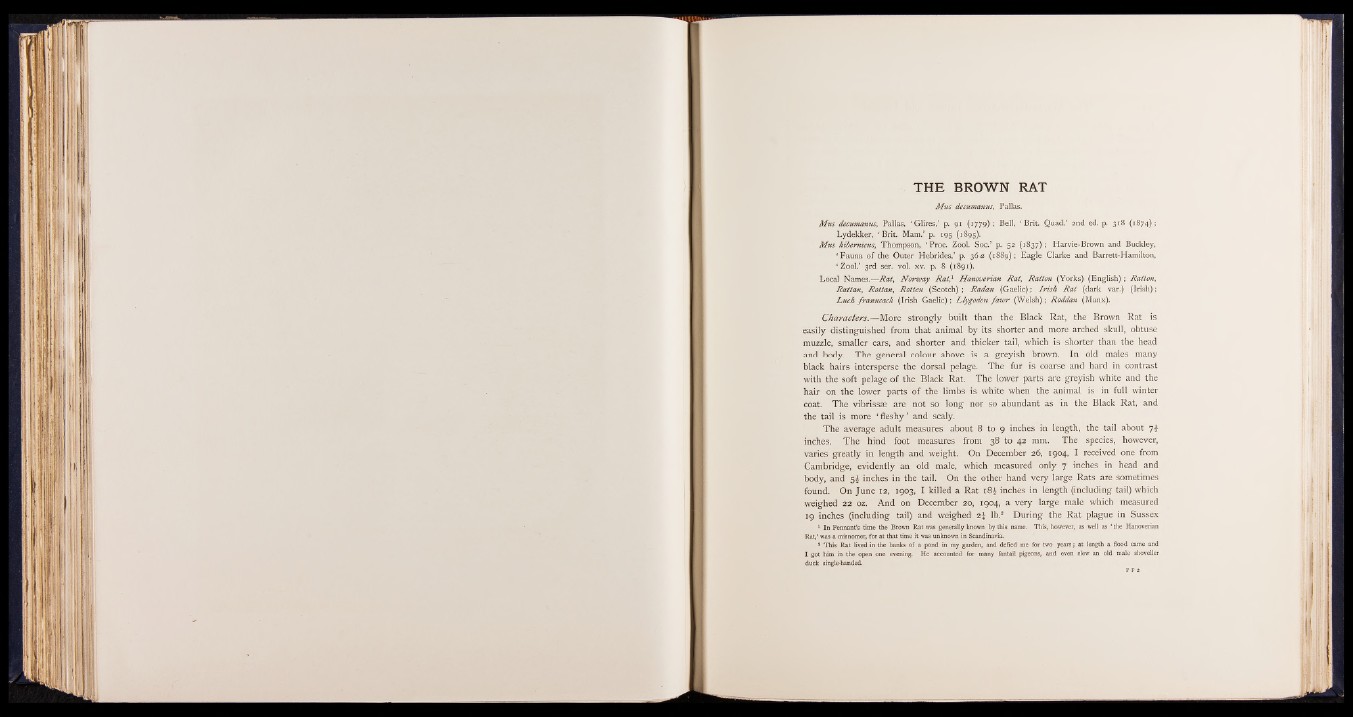
THE BROWN RAT
Mus decumanus, P allas .
Mus decumanus, P a lla s , ‘ G lir e s ,’ p . 9 1 (1779); B e ll, ‘ B rit. Q u ad .’ 2nd ed. p. 3 1 8 ( 1 8 7 4 ) ;
L y d e k k e r , ‘ B r it .-M am .’ p. 19 5 (18 9 5 ) .
Mus kibemicus, T h om p son , ‘ P roc . Z oo l. S o c .’ p. 5 2 ( 1 8 3 7 ) ; H a rv ie -B row n and B u ck le y ,
‘ F a u n a o f th e Ou te r H e b r id e s ,’ p. 3 6 a ( 1 8 8 9 ) ; E a g l e C la rk e an d B arre tt-Ham ilto n,
‘ Z o o l.’ 3 rd se r. v ol. x v . p . 8 ( 1 8 9 1 ) .
L o c a l N am e s .— Rat, Norway Rat,1 Hanoverian Rat, Ratton (Y o rk s ) ( E n g l is h ) ; Ratton,
Rattan, Rottan, Rotten (S co tch ) ; Radan (G a e l ic ) ; Irish Rat (d ark v a r .) ( I r i s h ) ;
Luck franncach ( I rish G a e l i c ) ; Llygoden fa w r (W e l s h ) ; Roddan (M an x ) .
Characters.—More strongly built than the Black Rat, the Brown Rat is
easily distinguished from that animal by its shorter and more arched skull, obtuse
muzzle, smaller ears, and shorter and thicker tail, which is shorter than the head
and body. The general colour above is a greyish brown. In old males many
black hairs intersperse the dorsal pelage. The fur is coarse and hard in contrast
with the soft pelage of the Black Rat. The lower parts are greyish white and the
hair on the lower parts of the limbs is white when the animal is in full winter
coat. The vibrissas are not so long nor so abundant as in the Black Rat, and
the tail is more ‘ fleshy’ and scaly.
The average adult measures about 8 to 9 inches in length, the tail about 7^
inches. The hind foot measures from 38 to 42 mm. The species, however,
varies greatly in length and weight. On December 26, 1904» I received one from
Cambridge, evidently an old male, which measured only 7 inches in head and
body, and 5^ inches in the tail. On the other hand very large Rats are sometimes
found. On June 12, 1903, I killed a Rat i8£ inches in length (including tail) which
weighed 22 oz. And on December 20, 1904, a very large male which measured
19 inches (including tail) and weighed 2$ lb.2 During the Rat plague in Sussex
1 In Pennant’s time the Brown Rat was generally known by this name. This, however, as well as ‘ the Hanoverian
Rat,’ was a misnomer, for at that time it was unknown in Scandinavia.
2 This Rat lived in the banks of a pond in my garden, and defied me for two years; at length a flood came and
I got him in the open one evening. He accounted for many fantail pigeons, and even slew an old male shoveller
duck single-handed.